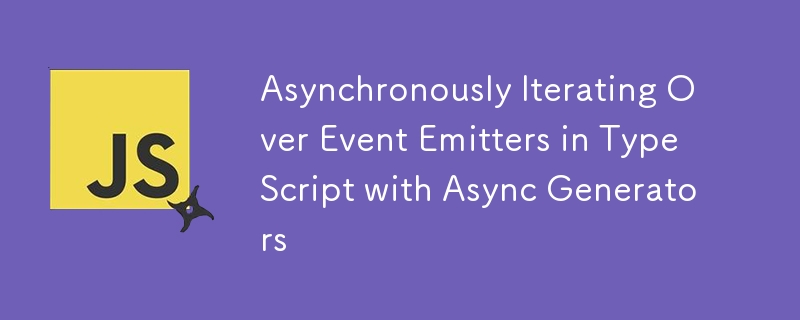非同期ジェネレーターを使用した TypeScript でのイベント エミッターの非同期反復

導入
現代の Web 開発では、受信 WebSocket メッセージ、サーバー送信イベント (SSE)、または Redis Pub/Sub などのサービスからのデータ ストリームの処理など、イベントを扱うことがよくあります。 Node.js はイベント駆動型の機能を提供しますが、for await...of ループを使用してイベントを非同期に反復するすぐに使用できる方法がありません。
この投稿では、TypeScript と AsyncGenerator を使用して非同期イベント イテレーターを作成するシンプルかつ強力な方法を説明します。このアプローチは、キャンセルとクリーンアップ ロジックを完全に制御しながら、あらゆる種類のイベント エミッターからのイベントをクリーンかつ予測可能な方法で使用できるように設計されています。
ユースケース: Redis Pub/Sub
最近のプロジェクトの 1 つでは、Redis Pub/Sub チャネルをリッスンし、接続されているクライアントにサーバー送信イベント (SSE) を非同期的にディスパッチする必要がありました。課題は、コンシューマーがいつでもイベント ストリームをキャンセルできるようにしながら、システムに負荷をかけずに受信イベントを処理することでした。
解決策は?任意のイベント エミッター (Redis Pub/Sub など) を非同期反復可能に変換するイベント イテレーター。これにより、制御された方法でイベントを処理し、必要に応じてキャンセルを適切に処理できるようになります。
実装を見ていきましょう。
コード
export type Context= { emit: (value: T) => void; cancel: () => void; }; export type CleanupFn = () => void | Promise ; export type Subscriber = ( context: Context , ) => void | CleanupFn | Promise ; export async function* createEventIterator ( subscriber: Subscriber , ): AsyncGenerator { const events: T[] = []; let cancelled = false; // Create a promise that resolves whenever a new event is added to the events array let resolveNext: (() => void) | null = null; const emit = (event: T) => { events.push(event); // If we are awaiting for a new event, resolve the promise if (resolveNext) { resolveNext(); resolveNext = null; } }; const cancel = () => { cancelled = true; }; const unsubscribe = await subscriber({ emit, cancel }); try { while (!cancelled) { // If there are events in the queue, yield the next event if (events.length > 0) { yield events.shift()!; } else { // Wait for the next event await new Promise ((resolve) => { resolveNext = resolve; }); } } // Process any remaining events that were emitted before cancellation. while (events.length > 0) { yield events.shift()!; } } finally { await unsubscribe?.(); } }
仕組み
この関数は、任意のイベント エミッターまたはパブリッシュ/サブスクライブ システムにフックできるサブスクライバー関数を受け入れます。サブスクライバーは 2 つの重要なメソッドを提供します:
- emit: サブスクライバが新しいイベントをイテレータにプッシュできるようにします。
- cancel: 反復を停止する必要があることを通知する方法を提供します。
この関数は AsyncGenerator
コードを分解する
コンテキスト オブジェクト:
Context型は、新しいイベントを発行したり、サブスクリプションをキャンセルしたりするためのインターフェイスを提供します。サブスクライバは、このコンテキストを使用してイベント フローを制御します。 イベントキュー:
events: T[] 配列は、発行されたイベントを格納するバッファとして機能します。ジェネレーターはこれらのイベントを 1 つずつ処理します。キューにイベントがない場合は、次のイベントが発行されるまで待機します。エミットロジック:
Emit 関数は、新しいイベントをキューに追加し、保留中の Promise を解決します (つまり、ジェネレーターが新しいイベントを待っている場合)。キャンセル:
cancel 関数が呼び出されると、ループを終了する必要があることを示すフラグ (canceled = true) が設定されます。キュー内に残っているイベントは、ジェネレーターが完了する前に処理されます。掃除:
キャンセル後、ジェネレーターは unsubscribe 関数 (指定されている場合) を呼び出して、必要なクリーンアップを実行します。これは、Redis などの外部システムからのサブスクライブを解除したり、リソースをクリーンアップしたりする場合に特に重要です。
例: Redis Pub/Sub のリスニング
このイベント イテレータを使用して Redis Pub/Sub をリッスンし、受信メッセージを非同期に反復処理する方法を見てみましょう。
import Redis from 'ioredis';
function redisEventIterator(channel: string) {
const client = new Redis();
return createEventIterator(({ emit, cancel }) => {
const messageHandler = (channel: string, message: string) => {
emit(message);
};
// Subscribe to the channel
client.subscribe(channel);
client.on('message', messageHandler);
// Cleanup function to unsubscribe and disconnect
return async () => {
client.off('message', messageHandler);
await client.unsubscribe(channel);
await client.quit();
};
});
}
// Usage
(async () => {
for await (const message of redisEventIterator('my-channel')) {
console.log('New message:', message);
// You can cancel the event stream if needed
if (message === 'STOP') {
break;
}
}
})();
この例では、createEventIterator を使用して Redis Pub/Sub チャネルにサブスクライブし、メッセージを非同期的に反復処理します。新しいメッセージが到着するたびに、それはジェネレーターに出力され、そこでリアルタイムで処理できます。特定のメッセージ (「STOP」など) を受信した場合、ループを終了し、Redis からサブスクライブを解除します。
例: EventEmitter の使用
Node.js の EventEmitter で createEventIterator を使用する方法は次のとおりです:
import { EventEmitter } from 'events';
function eventEmitterIterator(emitter: EventEmitter, eventName: string) {
return createEventIterator(({ emit, cancel }) => {
const eventHandler = (data: string) => emit(data);
emitter.on(eventName, eventHandler);
// Cleanup function to remove the listener
return () => {
emitter.off(eventName, eventHandler);
};
});
}
// Usage
(async () => {
const emitter = new EventEmitter();
// Simulate event emissions
setTimeout(() => emitter.emit('data', 'First event'), 1000);
setTimeout(() => emitter.emit('data', 'Second event'), 2000);
setTimeout(() => emitter.emit('data', 'STOP'), 3000);
for await (const event of eventEmitterIterator(emitter, 'data')) {
console.log('Received event:', event);
if (event === 'STOP') {
break;
}
}
})();
この例では:
- EventEmitter を使用してイベントを発行し、createEventIterator によってキャプチャされます。
- イテレータは「data」イベントをリッスンし、それを非同期的に処理します。
- Redis の例と同様に、特定のイベント ('STOP') を受信したときに反復を停止できます。
このアプローチの利点
非同期制御: AsyncGenerator を活用することで、イベントを非同期に処理し、自分のペースで処理し、必要に応じて処理を一時停止できます。
キャンセル: イベント ストリームをいつでもキャンセルできるため、特に接続を正常に閉じる必要がある現実のシナリオでは、このアプローチが柔軟になります。
汎用: このイテレータは任意のイベント エミッタまたは Pub/Sub システムに使用できるため、さまざまなアプリケーションに多用途に使用できます。
結論
イベント駆動型アーキテクチャは、多くの最新の Web アプリケーションの基礎ですが、イベント フローを非同期に制御する必要がある場合、管理が難しくなる可能性があります。 TypeScript の AsyncGenerator の機能を利用すると、このイベント イテレータのような洗練されたソリューションを構築でき、イベント処理コードがよりクリーンになり、保守が容易になります。
この投稿が、独自のイベント エミッターの非同期イテレーターの使用を開始するのに役立つことを願っています。ご質問やご意見がございましたら、お気軽にコメント欄で共有してください。
-
 Javaのコレクショントラバーサルのために、for-for-eachループとイテレーターを使用することにパフォーマンスの違いはありますか?vs. Iterator:コレクショントラバーサルの効率この記事では、これら2つのアプローチの効率の違いを調査します。内部的にiteratorを使用します: list a = new ArrayList (); for(整数整数:a){ integer.toString(); } ...プログラミング 2025-07-03に投稿されました
Javaのコレクショントラバーサルのために、for-for-eachループとイテレーターを使用することにパフォーマンスの違いはありますか?vs. Iterator:コレクショントラバーサルの効率この記事では、これら2つのアプローチの効率の違いを調査します。内部的にiteratorを使用します: list a = new ArrayList (); for(整数整数:a){ integer.toString(); } ...プログラミング 2025-07-03に投稿されました -
 CSSは言語分析を強く入力しましたプログラミング言語を分類する方法の1つは、それがどれほど強くまたは弱く入力されているかによってです。ここで、「タイプされた」とは、変数がコンパイル時に既知の場合を意味します。これの例は、整数(1)が整数( "1")を含む文字列に追加されるシナリオです: result = 1 ...プログラミング 2025-07-03に投稿されました
CSSは言語分析を強く入力しましたプログラミング言語を分類する方法の1つは、それがどれほど強くまたは弱く入力されているかによってです。ここで、「タイプされた」とは、変数がコンパイル時に既知の場合を意味します。これの例は、整数(1)が整数( "1")を含む文字列に追加されるシナリオです: result = 1 ...プログラミング 2025-07-03に投稿されました -
 コンパイラエラー「USR/BIN/LD:-L」ソリューションが見つかりませんエラーが発生したエラー: "usr/bin/ld:l " はプログラムをコンパイルしようとすると、次のエラーメッセージに遭遇する可能性があります: -l usr/bin/ld: cannot find -l<nameOfTheLibrary> ld ...プログラミング 2025-07-03に投稿されました
コンパイラエラー「USR/BIN/LD:-L」ソリューションが見つかりませんエラーが発生したエラー: "usr/bin/ld:l " はプログラムをコンパイルしようとすると、次のエラーメッセージに遭遇する可能性があります: -l usr/bin/ld: cannot find -l<nameOfTheLibrary> ld ...プログラミング 2025-07-03に投稿されました -
 CSSは、属性値に基づいてHTML要素を見つけることができますか?をCSS の属性値でHTML要素をターゲットとするCSSのターゲティング、以下の例に示すように、特定の属性に基づいてターゲット要素をターゲットにすることが可能です: [型]入力[型]入力[タイプ] { フォントファミリー:コンソラ。 } input[type=text] { ...プログラミング 2025-07-03に投稿されました
CSSは、属性値に基づいてHTML要素を見つけることができますか?をCSS の属性値でHTML要素をターゲットとするCSSのターゲティング、以下の例に示すように、特定の属性に基づいてターゲット要素をターゲットにすることが可能です: [型]入力[型]入力[タイプ] { フォントファミリー:コンソラ。 } input[type=text] { ...プログラミング 2025-07-03に投稿されました -
 CSSを使用してChromeとFirefoxのコンソール出力を着色できますか?javaScriptコンソールの色の表示 は、クロムのコンソールを使用してエラー用の赤、警告用のオレンジ、コンソール用グリーンなどの色のテキストを表示することは可能です。メッセージ? 回答 はい、CSSを使用して、ChromeとFirefox(バージョン31以降)のコンソールに表示さ...プログラミング 2025-07-03に投稿されました
CSSを使用してChromeとFirefoxのコンソール出力を着色できますか?javaScriptコンソールの色の表示 は、クロムのコンソールを使用してエラー用の赤、警告用のオレンジ、コンソール用グリーンなどの色のテキストを表示することは可能です。メッセージ? 回答 はい、CSSを使用して、ChromeとFirefox(バージョン31以降)のコンソールに表示さ...プログラミング 2025-07-03に投稿されました -
 フォームリフレッシュ後に重複した提出を防ぐ方法は?を更新することで重複した提出を防ぐ Web開発で、フォームの提出後にページが更新された場合に重複した提出の問題に遭遇することが一般的です。これに対処するには、次のアプローチを検討してください。 if(isset($ _ post ['name'])){ ...プログラミング 2025-07-03に投稿されました
フォームリフレッシュ後に重複した提出を防ぐ方法は?を更新することで重複した提出を防ぐ Web開発で、フォームの提出後にページが更新された場合に重複した提出の問題に遭遇することが一般的です。これに対処するには、次のアプローチを検討してください。 if(isset($ _ post ['name'])){ ...プログラミング 2025-07-03に投稿されました -
 右のテーブルの句でフィルタリングするとき、なぜ左結合が接続内に見えるのですか?left join conundrum:witching時間:データベースウィザードの領域で内側の結合 に変わる時間は、左結合を使用して複雑なデータ検索を実行することは一般的な慣行です。ただし、時々、左の結合が予想通りに動作しないことがあります。 A.foo、 B.BAR、 C.Foobar...プログラミング 2025-07-03に投稿されました
右のテーブルの句でフィルタリングするとき、なぜ左結合が接続内に見えるのですか?left join conundrum:witching時間:データベースウィザードの領域で内側の結合 に変わる時間は、左結合を使用して複雑なデータ検索を実行することは一般的な慣行です。ただし、時々、左の結合が予想通りに動作しないことがあります。 A.foo、 B.BAR、 C.Foobar...プログラミング 2025-07-03に投稿されました -
 なぜ画像はまだChromeに境界があるのですか? `border:none;`無効な解決策cromeの画像境界を削除する 1つの頻繁な問題は、chromeとie9の画像を操作する際に遭遇する頻繁な問題です。および「国境:なし;」 CSSで。この問題を解決するには、次のアプローチを検討してください。スタイル。これを回避するには、次のCSS IDブロックを使用して、目的のパディ...プログラミング 2025-07-03に投稿されました
なぜ画像はまだChromeに境界があるのですか? `border:none;`無効な解決策cromeの画像境界を削除する 1つの頻繁な問題は、chromeとie9の画像を操作する際に遭遇する頻繁な問題です。および「国境:なし;」 CSSで。この問題を解決するには、次のアプローチを検討してください。スタイル。これを回避するには、次のCSS IDブロックを使用して、目的のパディ...プログラミング 2025-07-03に投稿されました -
 マウスクリック時にDiv内のすべてのテキストをプログラム的に選択するにはどうすればよいですか?マウスクリックでプログラムをプログラム的に選択する 質問 テキストコンテンツのdiv要素が与えられた場合、ユーザーは1つのマウスクリックでdiv内のテキスト全体をプログラム的に選択できますか?これにより、ユーザーは選択したテキストを簡単にドラッグアンドドロップしたり、直接コピーしたりできます。...プログラミング 2025-07-03に投稿されました
マウスクリック時にDiv内のすべてのテキストをプログラム的に選択するにはどうすればよいですか?マウスクリックでプログラムをプログラム的に選択する 質問 テキストコンテンツのdiv要素が与えられた場合、ユーザーは1つのマウスクリックでdiv内のテキスト全体をプログラム的に選択できますか?これにより、ユーザーは選択したテキストを簡単にドラッグアンドドロップしたり、直接コピーしたりできます。...プログラミング 2025-07-03に投稿されました -
 非同期操作を同時に実行し、JavaScriptでエラーを正しく処理する方法は?並行操作実行を待つ 問題のコードスニペットは非同期操作を実行する際の問題に遭遇します: この実装は、次の操作を開始する前に各操作の完了を順次待ちます。同時実行を有効にするには、修正されたアプローチが必要です。 getValue2async(); const value1 = awa...プログラミング 2025-07-03に投稿されました
非同期操作を同時に実行し、JavaScriptでエラーを正しく処理する方法は?並行操作実行を待つ 問題のコードスニペットは非同期操作を実行する際の問題に遭遇します: この実装は、次の操作を開始する前に各操作の完了を順次待ちます。同時実行を有効にするには、修正されたアプローチが必要です。 getValue2async(); const value1 = awa...プログラミング 2025-07-03に投稿されました -
 \ "while(1)vs。for(;;):コンパイラの最適化はパフォーマンスの違いを排除しますか?\"while(1)vs。for(;;):速度の違いはありますか? loops? 回答: では、ほとんどの最新のコンパイラでは、(1)と(;;)。コンパイラー: perl: の両方が(1)と(;;)が同じオプコードをもたらします。 1 入力 - > 2を入力します 2 NextSt...プログラミング 2025-07-03に投稿されました
\ "while(1)vs。for(;;):コンパイラの最適化はパフォーマンスの違いを排除しますか?\"while(1)vs。for(;;):速度の違いはありますか? loops? 回答: では、ほとんどの最新のコンパイラでは、(1)と(;;)。コンパイラー: perl: の両方が(1)と(;;)が同じオプコードをもたらします。 1 入力 - > 2を入力します 2 NextSt...プログラミング 2025-07-03に投稿されました -
 JavaのMap.EntryとSimpleEntryはどのようにキー価値ペア管理を単純化しますか?valueペアの包括的なコレクション:javaのmap.entry and simpleEntry をJavaで紹介します。 However, for scenarios where maintaining the order of elements is crucial and un...プログラミング 2025-07-03に投稿されました
JavaのMap.EntryとSimpleEntryはどのようにキー価値ペア管理を単純化しますか?valueペアの包括的なコレクション:javaのmap.entry and simpleEntry をJavaで紹介します。 However, for scenarios where maintaining the order of elements is crucial and un...プログラミング 2025-07-03に投稿されました -
 顔を検出するための原因とソリューション:エラー-215エラー処理: "エラー:(-215)!empty()in function detectectmultiscale" in opencv の解決済みの誤報を検出しようとする場合、 "関数DetectMultiscale。」このエラーは、通常、顔の検出のため...プログラミング 2025-07-03に投稿されました
顔を検出するための原因とソリューション:エラー-215エラー処理: "エラー:(-215)!empty()in function detectectmultiscale" in opencv の解決済みの誤報を検出しようとする場合、 "関数DetectMultiscale。」このエラーは、通常、顔の検出のため...プログラミング 2025-07-03に投稿されました -
 Pythonの理解を使用して辞書を効率的に作成するにはどうすればよいですか?python辞書の理解 Pythonでは、辞書の概念は新しい辞書を生成するための簡潔な方法を提供します。それらはリストの概念に似ていますが、いくつかの顕著な違いがあります。キーと値を明示的に指定する必要があります。たとえば、 d = {n:n ** 2の範囲(5)} これは、0〜4のキ...プログラミング 2025-07-03に投稿されました
Pythonの理解を使用して辞書を効率的に作成するにはどうすればよいですか?python辞書の理解 Pythonでは、辞書の概念は新しい辞書を生成するための簡潔な方法を提供します。それらはリストの概念に似ていますが、いくつかの顕著な違いがあります。キーと値を明示的に指定する必要があります。たとえば、 d = {n:n ** 2の範囲(5)} これは、0〜4のキ...プログラミング 2025-07-03に投稿されました -
 C#でインデントのために文字列文字を効率的に繰り返す方法は?インデンテーションのために文字列を繰り返す アイテムの深さに基づいて文字列をインデントするとき、文字列を繰り返します。 Constructor 同じ文字を繰り返すだけの場合、文字を受け入れる文字列コンストラクターを使用してそれを繰り返すことができます: string indent = ...プログラミング 2025-07-03に投稿されました
C#でインデントのために文字列文字を効率的に繰り返す方法は?インデンテーションのために文字列を繰り返す アイテムの深さに基づいて文字列をインデントするとき、文字列を繰り返します。 Constructor 同じ文字を繰り返すだけの場合、文字を受け入れる文字列コンストラクターを使用してそれを繰り返すことができます: string indent = ...プログラミング 2025-07-03に投稿されました
中国語を勉強する
- 1 「歩く」は中国語で何と言いますか? 走路 中国語の発音、走路 中国語学習
- 2 「飛行機に乗る」は中国語で何と言いますか? 坐飞机 中国語の発音、坐飞机 中国語学習
- 3 「電車に乗る」は中国語で何と言いますか? 坐火车 中国語の発音、坐火车 中国語学習
- 4 「バスに乗る」は中国語で何と言いますか? 坐车 中国語の発音、坐车 中国語学習
- 5 中国語でドライブは何と言うでしょう? 开车 中国語の発音、开车 中国語学習
- 6 水泳は中国語で何と言うでしょう? 游泳 中国語の発音、游泳 中国語学習
- 7 中国語で自転車に乗るってなんて言うの? 骑自行车 中国語の発音、骑自行车 中国語学習
- 8 中国語で挨拶はなんて言うの? 你好中国語の発音、你好中国語学習
- 9 中国語でありがとうってなんて言うの? 谢谢中国語の発音、谢谢中国語学習
- 10 How to say goodbye in Chinese? 再见Chinese pronunciation, 再见Chinese learning

























